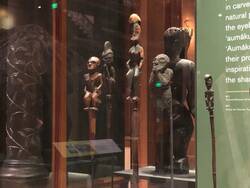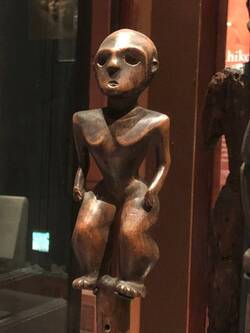Further Media


Producer unknown to us
Oceania, Polynesia, probably Tonga Archipelago (Lifuka/Ha'apai group)
Before 1781
Wood of the flower tree (Fagraea sp./Tongan: pua)
Acquired in 1773-74 or 1777 on Captain James Cook’s second or third expedition in the Pacific. It is yet unknown by whom the object was acquired.
Brought from Great Britain to Germany by Benjamin La Trobe, a Moravian working in London.
Inv. no. 68620
This female sculpture is one of the most unusual cultural artefacts from Polynesia, which was still untouched by Europeans 250 years ago. In fact, the ta-maka sculpture in the Herrnhut Cook Collection cannot be compared to any of the other “collector’s items” from Cook’s three voyages. This unique Herrnhut piece remains a mystery to this day. Even its place of origin can only be guessed at – with much pointing to the Tonga archipelago. Consider the material, for example: the female figure was carved from wood of the fragrant flower tree (Fragraea sp.; Tongan: pua), which is endemic to the neighboring archipelago of Samoa, but has also long been native to Tonga. A comparison with the design of female sculptures “collected” later also points in the direction of Tonga.
However, it is obvious that the Herrnhut female figure does not have the carefully polished form so typical of the Tongan archipelago. It is more likely that it was acquired in an unfinished state by one of Cook’s fellow travelers. Since such ta maka fakamanatu were made in the Tongan archipelago as female goddesses or ancestor figures for ceremonial and burial sites, a finished ancestor goddess already “consecrated” by the high priest would have been taboo for exchange with the British, or as a gift.
Assuming, however, that the Herrnhut female figure was acquired as an unfinished blank, this transfer probably took place on Lifuka in the center of the Tongan archipelago.